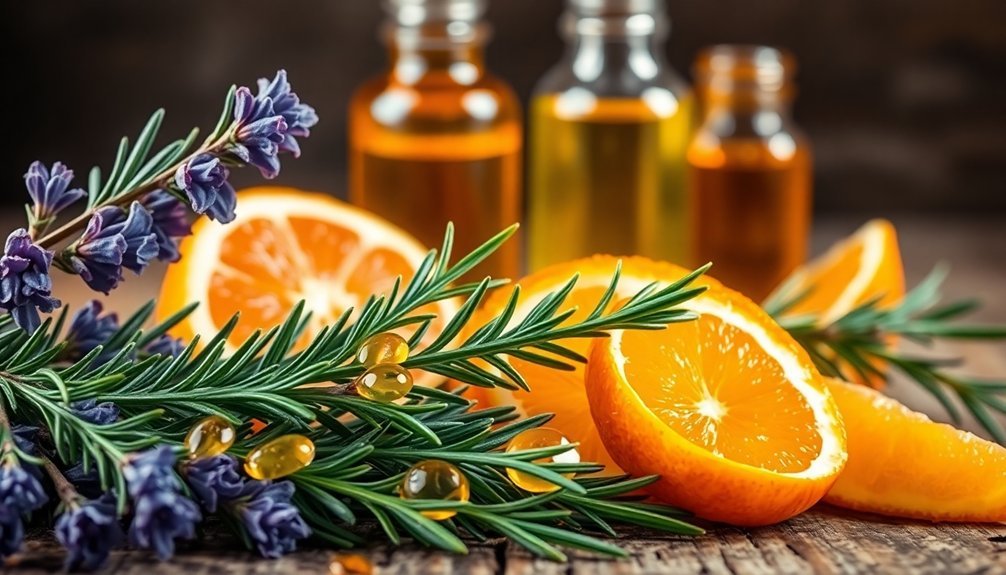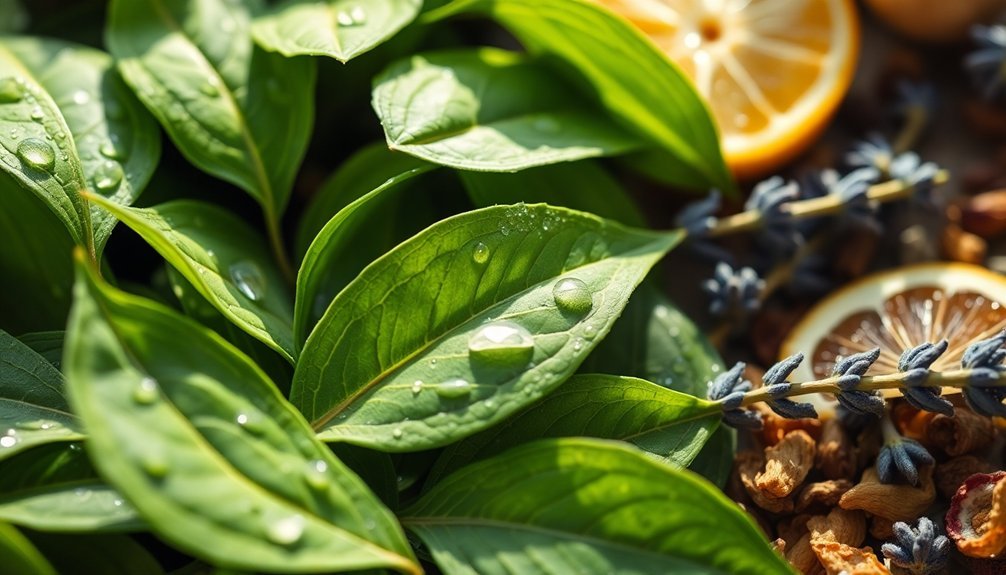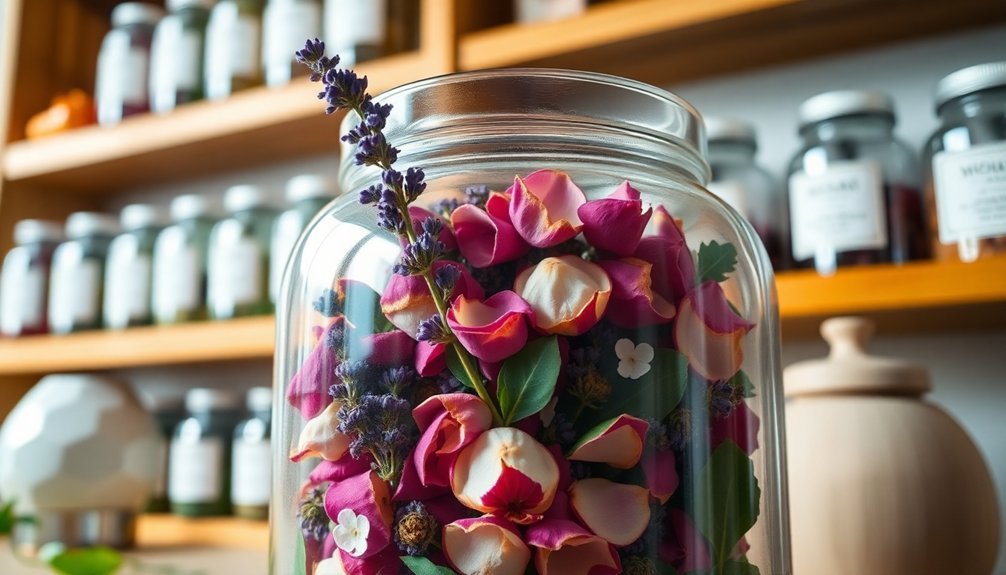Natural botanical preservatives can extend your fragrance blends' shelf life while maintaining their authentic scent profiles. The most effective options include rosemary extract (0.2-0.4%), vitamin E (0.1%), grapefruit seed extract (0.1-1.0%), and green tea extract (250-600mg per blend). You'll also want to evaluate benzyl alcohol with dehydroacetic acid, sorbic acid with potassium sorbate, and sodium benzoate combinations. Proper storage and strategic preservative pairings hold the key to revealing your blends' maximum longevity potential.
Understanding Botanical Preservatives in Natural Perfumery

While synthetic preservatives dominate the fragrance industry, botanical preservatives offer a natural alternative for creating long-lasting perfume blends.
You'll find these preservatives in various forms, from essential oils with antimicrobial properties to concentrated absolutes and CO2 extracts that help stabilize your fragrances.
When you're working with natural preservatives, you'll need to understand different extraction methods like enfleurage for delicate flowers and tincturing for stronger plant materials.
These processes not only preserve the aromatic compounds but also enhance their stability.
Even rare fragrances containing natural animal materials can provide exceptional preservation qualities and help extend the life of botanical blends.
You can further protect your blends by storing them properly – keep them in cool, dark places away from humidity and minimize air exposure.
Remember that natural perfumes typically last 1-3 years, so using smaller bottles and ensuring tight seals will help maintain their integrity longer.
Rosemary Extract: Nature's Perfume Guardian
Three powerful compounds – carnosol, carnosic acid, and mixed terpenes – make rosemary extract one of nature's most effective botanical preservatives for fragrance blends.
When you're formulating natural perfumes, you'll find this CO2-extracted powerhouse outperforms even mixed tocopherols in preventing oxidation.
You'll want to use rosemary extract at 0.2-0.4% in your formulations to maintain stability without compromising your blend's aroma.
While it's incredibly effective for oil-based fragrances, don't rely on it as your sole preservative for water-based formulas.
The extract remains stable at temperatures above 200°C and dissolves easily in most carrier oils. The very viscous liquid appears dark green and may contain some particulate matter requiring special blending.
Remember to keep the pH below 8.5 and always perform patch tests.
Despite its light rosemary scent, you won't notice it in your final product at recommended usage levels.
Vitamin E and Essential Oil Stability

You'll find Vitamin E in two primary forms: natural (d-alpha-tocopherol) and synthetic (dl-alpha-tocopherol), with the natural version offering superior antioxidant protection for your essential oils.
When added to your fragrance blends, Vitamin E actively fights oxidation by neutralizing free radicals that can degrade your oils' quality and scent profile. Essential oils are particularly susceptible to autoxidation chain reactions when exposed to atmospheric oxygen.
To maximize these protective benefits, store your Vitamin E-enhanced blends in dark glass bottles, keep them away from direct light and heat, and guarantee tight-fitting caps minimize oxygen exposure.
Vitamin E Types Explained
Vitamin E's effectiveness as a preservative in fragrance blends hinges on understanding its various forms. D-alpha-tocopherol stands out as the most biologically active type and your best choice for stabilizing essential oils.
While mixed tocopherols can work, they're less effective than alpha-tocopherol alone at preventing oxidation.
- Use d-alpha-tocopherol at 0.1% concentration by weight for ideal results
- Mix your vitamin E 50/50 with a carrier oil to manage viscosity
- Remember it's an antioxidant, not an antimicrobial preservative
The tocopherol family includes alpha, beta, gamma, and delta forms, plus their tocotrienol counterparts.
However, when you're specifically working with essential oils, d-alpha-tocopherol's superior stability and antioxidant properties make it the clear frontrunner for maintaining your fragrance blends' integrity.
Oxidation Prevention Benefits
Now that you understand the different types of vitamin E, let's explore how it actively prevents oxidation in fragrance blends.
When used at concentrations of 0.1% or less, vitamin E effectively protects your fragrance oils from breaking down due to light, heat, and moisture exposure. You'll find it particularly useful in stabilizing vegetable oils and essential oils, preventing them from turning rancid.
Temperature plays a significant role in essential oil stability, so you'll want to store your blends in controlled conditions. While some oils like rosemary remain stable at lower temperatures, others such as lavender may oxidize more quickly.
Adding vitamin E helps prevent the formation of hydroperoxides and other unwanted oxidation products. Remember that synthetic vitamin E offers better stability than natural variants when preserving your fragrance formulations.
Optimal Storage Methods
Three key storage factors dramatically influence the stability of vitamin E and essential oil blends: temperature, light exposure, and humidity control.
You'll need to maintain temperatures between 60°F and 70°F while storing your blends in dark amber or cobalt blue glass bottles to protect against UV damage.
Keep your mixtures in a dry, cool cabinet away from bathrooms or humid areas to prevent mold growth.
- Store citrus-based blends in the refrigerator to extend their shelf life and preserve their potency.
- Use airtight containers with secure dropper caps to minimize oxidation and maintain freshness.
- Label each bottle with the purchase date and contents to track shelf life and guarantee proper rotation.
Always replace lids immediately after use and store blends out of children's reach in opaque storage containers.
Grapefruit Seed Extract for Fragrance Protection
You'll find grapefruit seed extract (GSE) works best in fragrance blends at concentrations between 0.1% to 1.0%, though its natural antimicrobial properties are most effective at 1.5-3.0% in pure form.
While GSE offers protection against bacteria and fungi in your fragrance formulations, it's not a complete preservative system and needs to be combined with commercial preservatives for water-based products.
Your success with GSE depends on proper storage, small batch production, and careful ingredient compatibility testing, as it can interact unfavorably with anionic materials.
Effective Usage Guidelines
When incorporating grapefruit seed extract (GSE) into fragrance blends, precise measurement and careful consideration of compatibility factors are essential.
You'll need to stay within the recommended usage levels of 0.1% to 1.0% in finished formulations, though pure forms can be effective up to 3.0%. Remember that exceeding these levels may cause irritation.
- Always test GSE's compatibility with your existing ingredients, especially if you're using anionic substances or water-based formulations.
- When working with water-based blends, you'll need to supplement GSE with a full-spectrum commercial preservative.
- For best results, combine GSE with alcohol-based formulations, as the alcohol provides additional antimicrobial protection.
Store your GSE-containing blends in a cool, dark place to maintain their effectiveness for up to 24 months.
Benefits and Limitations
Despite its growing popularity in natural formulations, grapefruit seed extract (GSE) offers both significant advantages and notable drawbacks as a fragrance preservative.
You'll benefit from its powerful antimicrobial properties that combat bacteria, fungi, and viruses, while its antioxidant-rich composition helps maintain fragrance stability and freshness. GSE's compatibility with various solvents and non-toxic nature at proper dilutions makes it versatile for many applications.
However, you shouldn't rely on GSE as your sole preservative. It's limited by concentration restrictions, with a maximum safe level of 0.1%, and won't provide full-spectrum protection in water-based formulations.
You'll need to avoid using it with anionic ingredients, and be aware that some marketing claims about its preservative powers may be exaggerated. It works best in high-alcohol formulations where additional preservation is already present.
Green Tea Extract as an Antioxidant Shield

Green tea extract stands as a powerhouse of antioxidant protection for fragrance blends, primarily due to its rich concentration of catechins, especially epigallocatechin gallate (EGCG).
When you incorporate this botanical preservative into your fragrance formulations, you'll benefit from its ability to reduce oxidative stress and combat free radicals that can degrade your scent compounds.
- The extract's mechanism selectively increases beneficial gut bacteria, making it particularly effective when combined with other polyphenol-rich preservatives.
- Its natural ability to bind with docking receptors enhances the overall stability of your fragrance blend.
- You can achieve ideal preservation benefits with smaller, safer doses ranging from 250-600mg per formulation.
For topical applications, you'll find that green tea extract not only preserves your fragrance but also contributes to skin health, making it a dual-purpose ingredient in your blends.
Combining Natural Preservatives for Maximum Effect
Building upon the antioxidant power of green tea extract, a strategic combination of natural preservatives can create a robust defense system for your fragrance blends. You'll find that pairing complementary preservatives enhances their protective capabilities while maintaining your blend's natural integrity.
| Preservative Combo | Benefits |
|---|---|
| Benzyl Alcohol + Dehydroacetic Acid | Fights bacteria and yeasts |
| Sorbic Acid + Potassium Sorbate | Controls molds and extends shelf life |
| Sodium Benzoate + Potassium Sorbate | Ideal for water-based formulations |
| Natural Extracts + Phenoxyethanol | Provides dual antimicrobial protection |
Remember to maintain sterile conditions during production and control your product's pH level. While single preservatives offer limited protection, combining them strategically creates a broad-spectrum shield against microbial growth. You'll want to verify ingredient compatibility and follow supplier guidelines for peak results.
Storage Tips for Extended Fragrance Life

When it comes to preserving your fragrance blends, proper storage makes all the difference between a long-lasting scent and one that quickly deteriorates.
Keep your perfumes in a cool, dark place between 60-70°F, away from bathrooms and direct sunlight. A bedroom closet or dresser drawer provides ideal conditions to protect your fragrances from harmful UV rays and temperature fluctuations.
- Always cap your bottles tightly after use and clean the nozzle to prevent clogging.
- Consider using the refrigerator for storage if you can maintain consistent temperatures.
- When traveling, transfer your perfumes to smaller vessels and use protective travel kits.
Don't expose your fragrances to heating vents, windowsills, or areas with high humidity.
These simple storage practices will help maintain your perfume's chemical composition and preserve its intended scent profile.
Frequently Asked Questions
Can I Mix Different Botanical Preservatives Without Affecting the Fragrance Profile?
You can mix preservatives, but you'll need to carefully test combinations as they may affect your fragrance. Start with small batches and monitor how different preservatives interact with your scent profile.
How Do Seasonal Temperature Changes Impact the Effectiveness of Botanical Preservatives?
You'll notice seasonal temperatures considerably affect your botanical preservatives. During summer, they may degrade faster, while winter's cold can extend their shelf life but might alter their effectiveness and stability.
Are Botanical Preservatives Safe for People With Nut Allergies?
You'll need to check if your botanical preservatives contain refined or unrefined nut oils. Refined oils are generally safe, but unrefined ones can trigger allergic reactions. Always verify ingredients with manufacturers for safety.
What's the Minimum Concentration Needed for Botanical Preservatives to Work Effectively?
You'll need at least 0.5% concentration for botanical preservatives to work effectively, but your specific formulation may require up to 3% depending on water content and pH levels in your product.
Do Botanical Preservatives Alter the Color of Fragrance Blends Over Time?
Yes, botanical preservatives can alter your fragrance's color over time. You'll notice gradual changes due to natural molecular breakdown, especially when plant-based preservatives interact with other ingredients in your fragrance blend.
In Summary
You've now got the knowledge to preserve your natural fragrances effectively and sustainably. By incorporating these botanical preservatives into your blends, you'll extend their shelf life while maintaining their natural integrity. Remember to experiment with different combinations and always store your creations properly. Whether you're a hobbyist or professional perfumer, these natural preservation methods will help your scents stay fresh and vibrant longer.





Leave a Reply